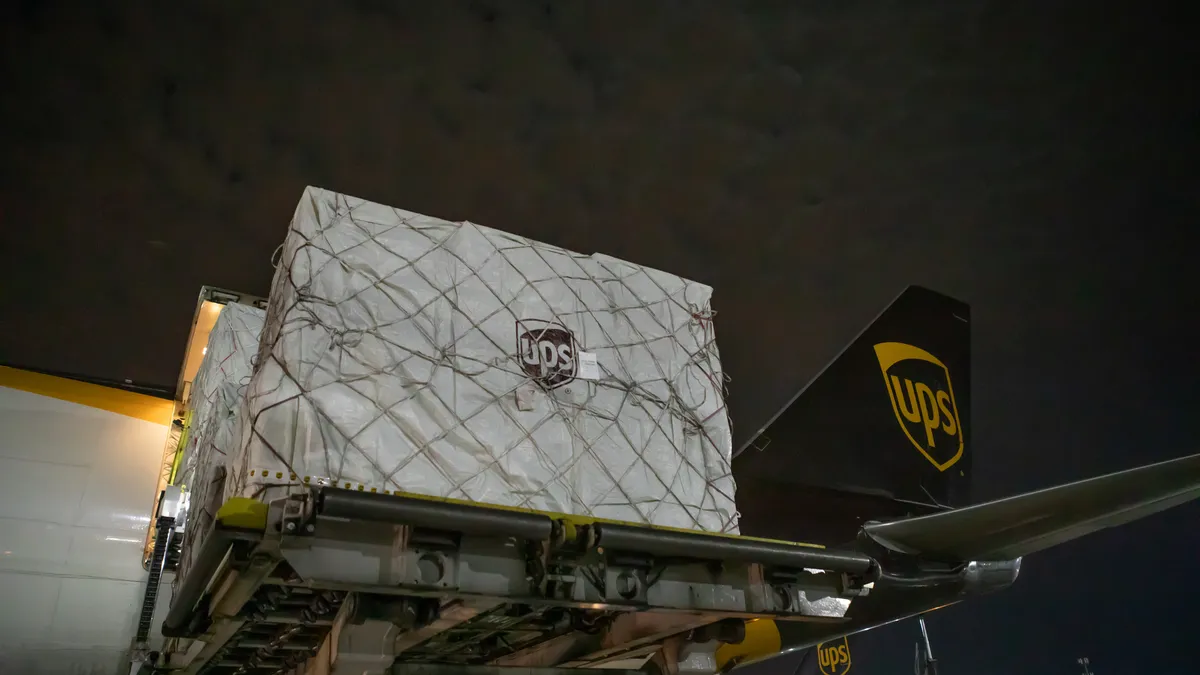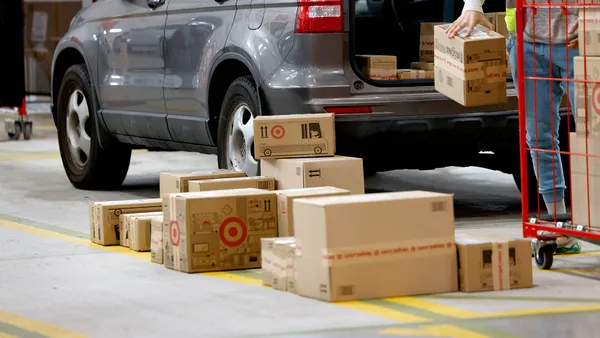Dive Brief:
- A combination of tight capacity and rising volume means logistics costs will continue to "improve" in UPS' favor, according to a research note from UBS, penned after a meeting between analysts at the bank and UPS' investor relations team.
- "UPS is transitioning to a slower pace of capacity addition in 2021 and we believe broader package industry capacity expansion is also likely to be modest," the research note reads. "Assuming a backdrop of economic growth in 2021, we believe the package market is likely to remain tight and support a path of pricing gains for UPS."
- UBS expects UPS' revenue from surcharges to be "significant," but the carrier didn't provide any guidance on the expected size of its peak surcharge revenue.
Dive Insight:
The pandemic has resulted in a whirlwind of changes to the volume flowing through UPS' network, the company explained in its earnings results at the end of July.
As businesses shuttered across the country, UPS' B2B volume tumbled nearly 22% year over year (YoY) in the second quarter. But with people stuck at home and e-commerce booming, B2C volume shot up more than 65% over the same period of time — growing to represent 69% of the carrier's total volume.
"The surge created some network constraints and some regional dips in service levels," UPS CFO Brian Newman said on the company's earnings call.
On the same call, the carrier's new CEO, Carol Tomé, outlined the idea that UPS will be conservative in its capacity-building. She said the carrier's "theme is better, not bigger, optimizing the capacity that we have."
Tomé used the carrier's air fleet to illustrate her point. As the pandemic raged, passenger planes canceled flights, which pulled belly capacity from the market; at the same time, shippers were desperate to move personal protective equipment from manufacturers in Asia to buyers in North America. Airfreight rates skyrocketed. UPS added hundreds of flights in support of the Federal Emergency Management Agency's Project Airbridge, but when the carrier had the option to buy more wide-body 747s, it decided against it.
"And the question that we asked ourselves is, well, won’t that create excess capacity?" Tomé said on the earnings call. "And won’t we find that we’ll need to fill that capacity at perhaps non-nutritive ways. And the answer to that question was, 'yes.' So we passed on that investment that, in the past, we might have made."
A UPS spokesperson said the carrier added 22 "high capacity aircraft" between 2018 and 2019 with plans to bring in 11 more this year.
"As we move forward, we are optimizing the investments that we have already made before we consider additional capacity investments," the company spokesperson said. "We will continue to invest in a targeted fashion in our network in 2021."
The carrier has also added 42 buildings with automated capacity over 2018 and 2019.
"In 2020, we plan to bring on approximately 5 million square feet of new, automated sort capacity globally, with nearly all of that new capacity available before the peak holiday season," a company spokesperson explained in an email.
This pressure on capacity could restrain the volume growth in the fourth quarter and could make it more expensive for shippers, UBS said in its note.
"Our discussions with industry contacts indicate that both UPS and [FedEx] are raising rates with shippers and in some cases re-opening contracts to raise rates," UBS said in its note.
Meanwhile, shippers are increasingly turning to smaller, regional logistics companies to help handle some of the increased volumes. But if shippers see these regional carriers as a low-cost alternative to increasing rates at UPS and FedEx then they might want to think again.
"The regional carriers are so small collectively that they would collapse under the weight of some shippers just dumping all the packages on them, they would not be able to handle it," said Satish Jindel, the president of ShipMatrix.














